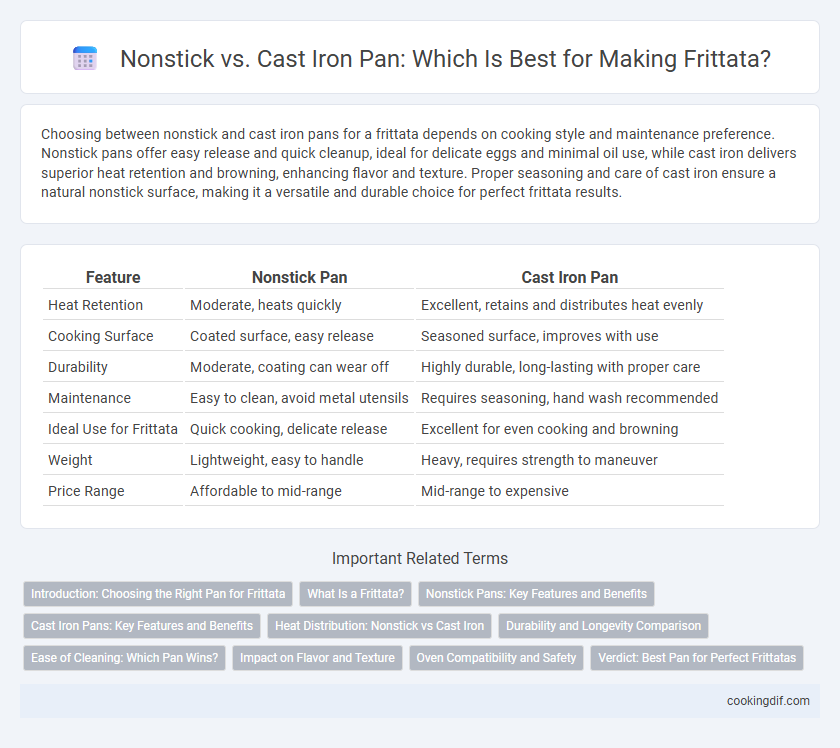Choosing between nonstick and cast iron pans for a frittata depends on cooking style and maintenance preference. Nonstick pans offer easy release and quick cleanup, ideal for delicate eggs and minimal oil use, while cast iron delivers superior heat retention and browning, enhancing flavor and texture. Proper seasoning and care of cast iron ensure a natural nonstick surface, making it a versatile and durable choice for perfect frittata results.
Table of Comparison
| Feature | Nonstick Pan | Cast Iron Pan |
|---|---|---|
| Heat Retention | Moderate, heats quickly | Excellent, retains and distributes heat evenly |
| Cooking Surface | Coated surface, easy release | Seasoned surface, improves with use |
| Durability | Moderate, coating can wear off | Highly durable, long-lasting with proper care |
| Maintenance | Easy to clean, avoid metal utensils | Requires seasoning, hand wash recommended |
| Ideal Use for Frittata | Quick cooking, delicate release | Excellent for even cooking and browning |
| Weight | Lightweight, easy to handle | Heavy, requires strength to maneuver |
| Price Range | Affordable to mid-range | Mid-range to expensive |
Introduction: Choosing the Right Pan for Frittata
Selecting the right pan for making a frittata is crucial for achieving even cooking and easy serving. Nonstick pans offer smooth surfaces that prevent sticking and allow effortless flipping or sliding, while cast iron pans provide superior heat retention and develop a natural seasoning that enhances flavor over time. Understanding these differences helps cooks decide between convenience and durability when preparing the perfect frittata.
What Is a Frittata?
A frittata is an Italian-style omelette made by combining beaten eggs with various ingredients like vegetables, cheese, and meats, then cooking slowly on the stovetop before finishing under a broiler or in the oven. Choosing between a nonstick and cast iron pan affects cooking: nonstick pans provide even heat distribution and easy release, ideal for delicate eggs, while cast iron offers superior heat retention and a naturally seasoned surface, enhancing flavor and creating a crispy crust. Both pan types influence the texture and ease of flipping the frittata, making the choice dependent on desired cooking style and maintenance preferences.
Nonstick Pans: Key Features and Benefits
Nonstick pans offer superior ease of use for cooking frittatas, featuring a smooth, coated surface that prevents eggs from sticking and ensures effortless flipping and serving. Their lightweight design allows for quick temperature adjustments and even heat distribution, reducing the risk of burnt edges and promoting uniform cooking. Easy cleanup and minimal oil requirements make nonstick pans an efficient and health-conscious choice for preparing delicate egg dishes like frittatas.
Cast Iron Pans: Key Features and Benefits
Cast iron pans offer superior heat retention and even cooking, essential for achieving the perfect frittata texture with a golden, crispy crust. Their natural nonstick seasoning improves over time, reducing the need for excess oil and enhancing flavor. Durable and versatile, cast iron pans transition seamlessly from stovetop to oven, allowing for easy finishing of frittatas under high heat.
Heat Distribution: Nonstick vs Cast Iron
Cast iron pans excel in heat distribution due to their thick, dense material that retains and spreads heat evenly, ensuring a perfectly cooked frittata with consistent texture. Nonstick pans offer quicker heat response but often have thin bases that can create hot spots, potentially causing uneven cooking or browning. For optimal heat distribution in frittata preparation, cast iron provides superior performance, especially for slow and steady cooking.
Durability and Longevity Comparison
Cast iron pans offer superior durability and longevity, often lasting a lifetime with proper seasoning and care, making them an excellent investment for cooking frittatas. Nonstick pans, while convenient for easy release and cleanup, generally have a shorter lifespan due to coating degradation from high heat and metal utensils. Choosing cast iron ensures consistent heat retention and a robust surface that improves with use, whereas nonstick pans may require frequent replacement to maintain optimal performance.
Ease of Cleaning: Which Pan Wins?
Nonstick pans offer superior ease of cleaning for frittatas, as their smooth surfaces prevent eggs from sticking and require minimal scrubbing. Cast iron pans, while excellent for heat retention and flavor development, demand thorough seasoning and careful hand-washing to maintain their nonstick properties. For convenient cleanup and consistent release, nonstick pans generally win in ease of cleaning.
Impact on Flavor and Texture
Nonstick pans provide a smooth surface that prevents sticking, resulting in a tender, evenly cooked frittata with a delicate texture and minimal browning. Cast iron pans develop a natural seasoning over time, imparting a rich, slightly smoky flavor and creating a crispy, caramelized crust on the frittata's edges. The choice between nonstick and cast iron significantly influences the flavor profile and texture, with cast iron enhancing depth and crispness while nonstick prioritizes ease and softness.
Oven Compatibility and Safety
Nonstick pans offer excellent oven compatibility up to temperatures typically around 450degF, ensuring ease of use without risk of coating damage, making them safe for most oven settings. Cast iron pans provide superior heat retention and can withstand very high oven temperatures, often exceeding 500degF, without warping or releasing harmful substances, making them exceptionally safe for oven cooking. Both pan types offer safe oven use, but cast iron is preferred for high-heat frittata baking due to its durability and heat conductivity.
Verdict: Best Pan for Perfect Frittatas
Cast iron pans provide superior heat retention and even cooking, essential for achieving the perfect frittata with a crispy edge and tender center. Nonstick pans offer easy release and simpler clean-up, making them ideal for beginner cooks prioritizing convenience. For the best overall frittata, cast iron is preferred due to its ability to create a consistent texture and enhance flavor development.
Nonstick vs Cast Iron for pan type Infographic

 cookingdif.com
cookingdif.com